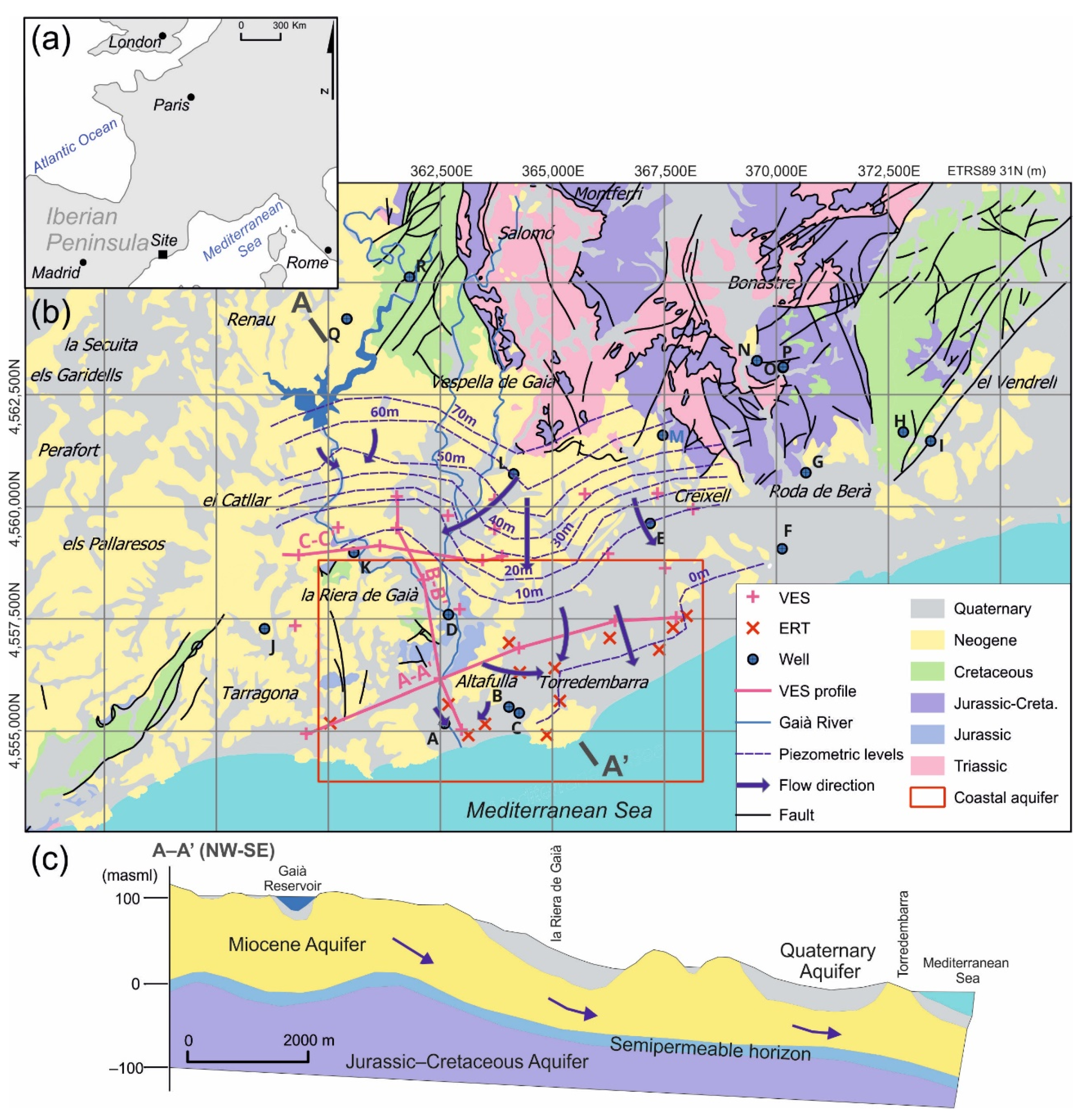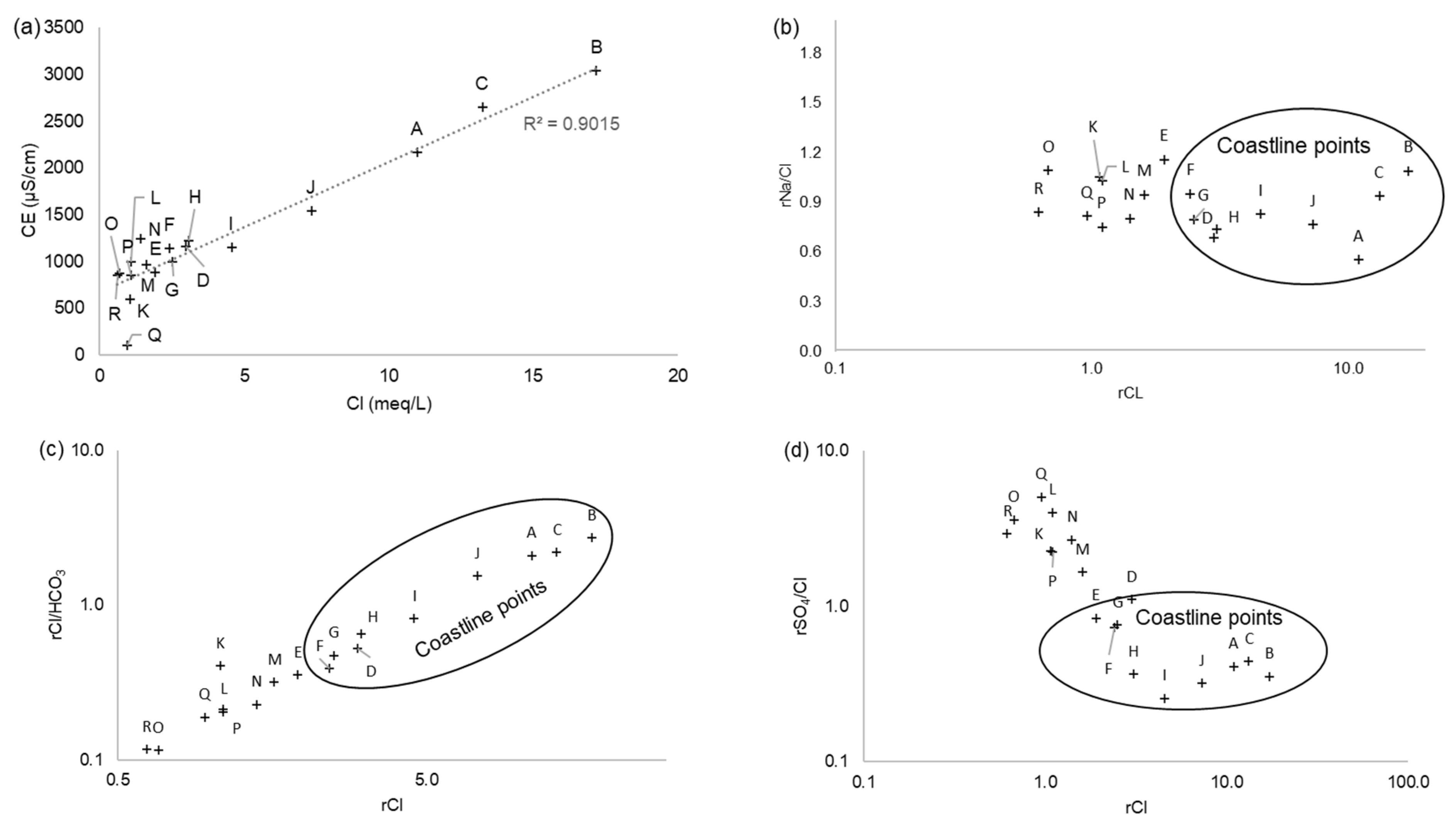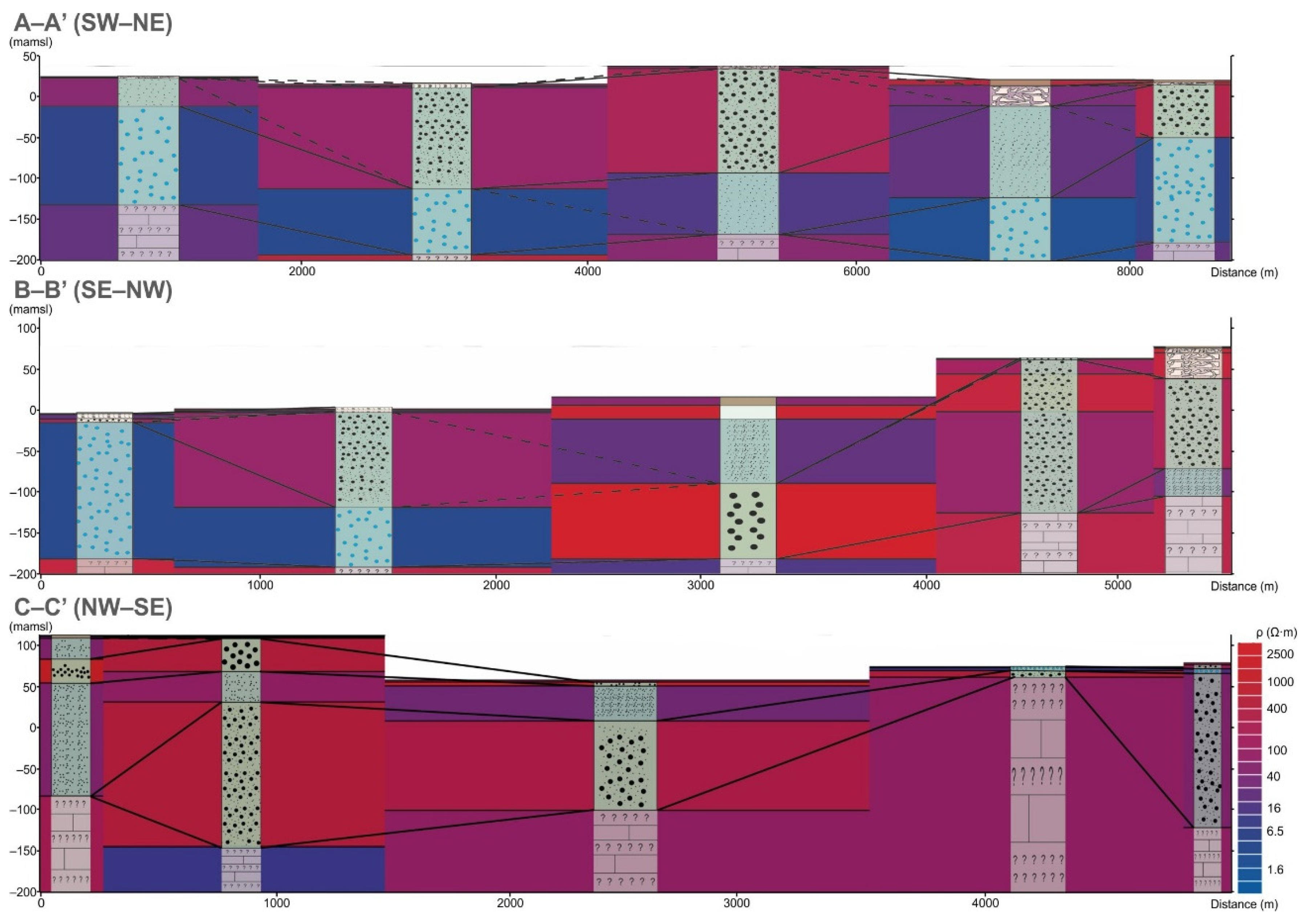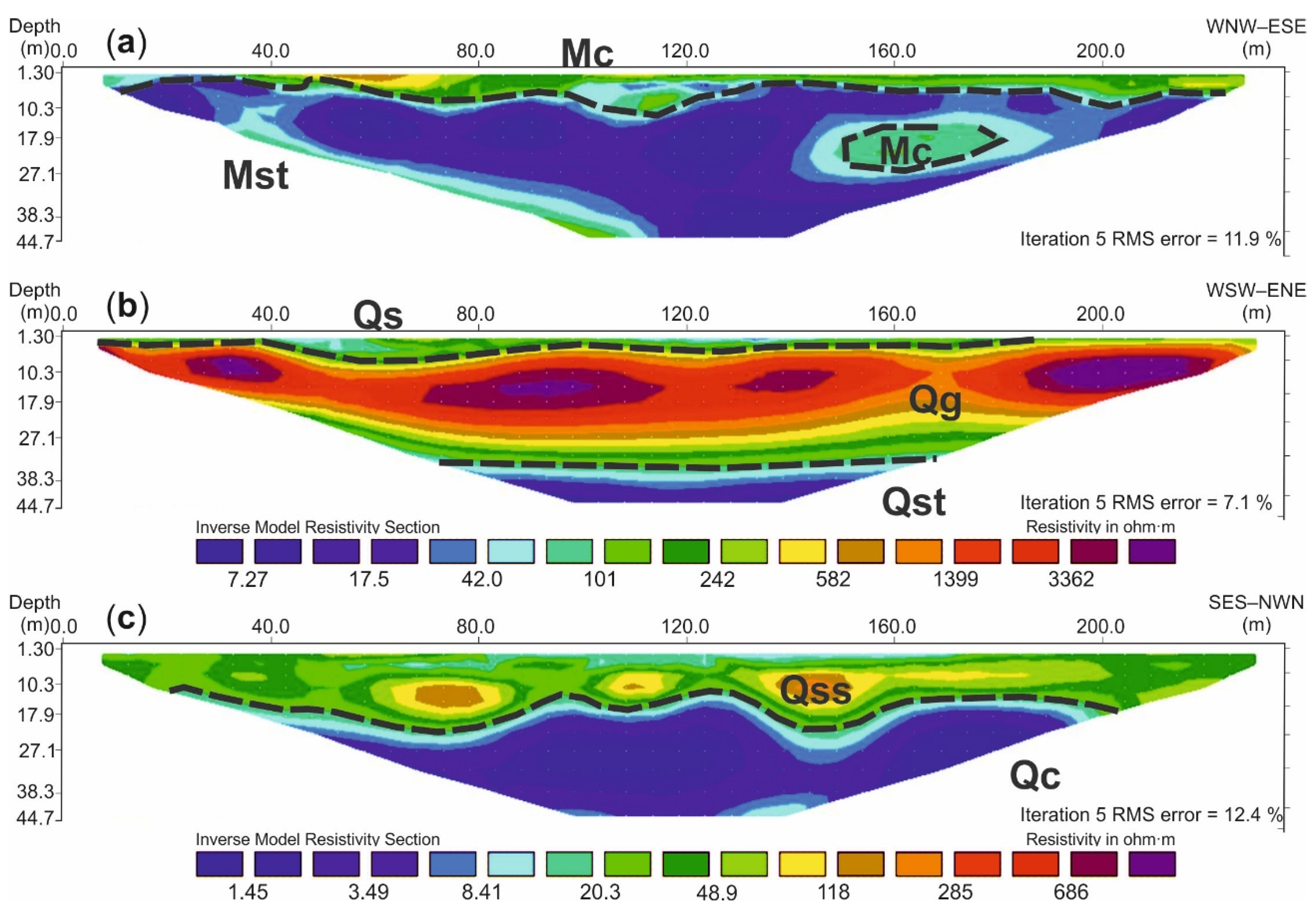Coupled Geophysical and Hydrogeochemical Characterization of a Coastal Aquifer as Tool for a More Efficient Management (Torredembarra, Spain)
Abstract
:1. Introduction
2. Study Area
3. Materials and Methods
3.1. Groundwater Quality Assessment
3.2. Geoelectrical Surveys
4. Results and Discussion
4.1. Groundwater Quality Assessment
- -
- As can be identified in Figure 2a, a clear linear relationship (Coefficient of Determination R2 = 0.9015) is identified where the increase in EC is directly related to the increase in chloride concentration. Since the chloride ion is a conservative ion and there are no geological units in the sector that could contribute this ion to the water, its origin, and concentration are related to anthropogenic origin and/or marine intrusion events.
- -
- The samples located upstream of the Riera de Gaià show lower concentrations of Na and Cl with respect to the more coastal waters (Figure 2b). However, it is important to mention that most of the samples are aligned, with a value of the ratio between these ions close to 0.85, a value of 0.85 corresponding to seawater composition.
- -
- -
4.2. Geophysical Surveys
- -
- 500–1000 Ω·m layer interpreted as gravels and/or carbonate rocks (Upper Pleistocene).
- -
- 5–50 Ω·m levels corresponding to clay and silt responses (Upper Pleistocene).
- -
- 100–200 Ω·m interpreted as sand and gravel (Holocene–Upper Pleistocene).
4.3. Hydrogeological Conceptual Model and Groundwater Salinization Map
- -
- High-depth groundwater salinity. ERT cross sections show lower base resistivity values, which could indicate water with a high salt concentration.
- -
- Medium-depth groundwater salinity. ERT cross sections show values related to brackish and/or saline water responses not exceeding 20 m depth.
- -
- Low-depth groundwater salinity. Saltwater intrusion is present in most of the cross-section and is located at a depth of approximately 7 m.
5. Conclusions
Author Contributions
Funding
Data Availability Statement
Acknowledgments
Conflicts of Interest
References
- Van der Gun, J. Groundwater and Global Change: Trends, Opportunities and Challenges|International Groundwater Resources Assessment Centre; United Nations Educational, Scientific and Cultural Organization: Paris, France, 2012; ISBN 9789230010492. [Google Scholar]
- Aeschbach-Hertig, W.; Gleeson, T. Regional strategies for the accelerating global problem of groundwater depletion. Nat. Geosci. 2012, 5, 853–861. [Google Scholar] [CrossRef]
- Akbarpour, S.; Niksokhan, M.H. Investigating effects of climate change, urbanization, and sea level changes on groundwater resources in a coastal aquifer: An integrated assessment. Environ. Monit. Assess. 2018, 190, 579. [Google Scholar] [CrossRef] [PubMed]
- Fetter, C.W. Applied Hydrogeology, 4th ed.; Prentice Hal: Upper Saddle River, NJ, USA, 2001; ISBN 0-13-088239-9. [Google Scholar]
- López-Geta, J.A.; de la Orden, J.A.; Gómez, J.D.; Ramos, G.; Mejías, M.; Rodriguez, L. Coastal Aquifers Intrusion Technology: Mediterranean Countries; Instituto Geológico y Minero de España: Madrid, Spain, 2003; ISBN 84-7840-469-4. [Google Scholar]
- Mastrocicco, M.; Colombani, N. The Issue of Groundwater Salinization in Coastal Areas of the Mediterranean Region: A Review. Water 2021, 13, 90. [Google Scholar] [CrossRef]
- Custodio Gimena, E. Evaluación de la Gestión y Gobernanza del Agua Subterránea: Aplicación a Áreas Seleccionadas Españolas: (EGASE); Universidad Politécnica de Cataluña: Barcelona, Spain, 2022; ISBN 9788498804324. [Google Scholar]
- Polemio, M.; Zuffiano, M. Review of Utilization Management of Groundwater at Risk of Salinization. J. Water Resour. Plan. Manag. 2020, 146, 3120002. [Google Scholar] [CrossRef]
- Losada, I.J.; Izaguirre, C.; Díaz, P. Cambio Climático en la Costa Española; Ministerio de Agricultura, Alimentación y Medio Ambiente, Gobierno de España: Madrid, Spain, 2014; ISBN 978-84-491-1403-8. [Google Scholar]
- Alfarrah, N.; Walraevens, K. Groundwater overexploitation and seawater intrusion in coastal areas of arid and semi-arid regions. Water 2018, 10, 143. [Google Scholar] [CrossRef]
- Alexander, L.; Allen, S.; Bindoff, N.; Breon, F.-M.; Church, J.; Cubasch, U.; Emori, S.; Forster, P.; Friedlingstein, P.; Gillett, N.; et al. Climate change 2013: The physical science basis, in contribution of Working Group I (WGI) to the Fifth Assessment Report (AR5) of the Intergovernmental Panel on Climate Change (IPCC). In Climate Change 2013: The Physical Science Basis; Cambridge University Press: Cambridge, UK, 2013. [Google Scholar]
- Post, V.E.A. Fresh and saline groundwater interaction in coastal aquifers: Is our technology ready for the problems ahead? Hydrogeol. J. 2005, 13, 120–123. [Google Scholar] [CrossRef]
- UNESCO. Framework for groundwater monitoring in (semi-)arid regions. In Studies in Hydrology 92-3-103679-7; Van Lanen, H., Carrillo-Rivera, J., Eds.; Paris, France, 1998; Volume 57, pp. 7–20. ISBN 92-3-103679-7. [Google Scholar]
- UNESCO. Submarine Groundwater Discharge: Management Implications, Measurements and Effects. Groundwater Series n. 5.; IHP: Paris, France, 2004; ISBN 92-9220-006-2. [Google Scholar]
- Margat, J.; van der Gun, J. Groundwater around the World: A Geographic Synopsis; CRC Press Taylor & Francis Group: Boca Raton, FL, USA, 2013; ISBN 978-1-138-00034-6. [Google Scholar]
- Sabater, S.; Barceló, D. Water Scarcity in the Mediterranean: Perspectives under Global Change; Springer: Berlin, Germany, 2010; ISBN 978-3-642-03970-6(H). [Google Scholar]
- López-Geta, J.A. La gestión de los acuíferos costeros como fuente de un recurso importante y estratégico. progreso y futuro; In Las Aguas Subterráneas en la Ley de Aguas Española: Un Decenio de Experiencia; AIH: Madrid, Spain, 1995; pp. 221–237. [Google Scholar]
- Custodio, E. Coastal aquifers of Europe: An overview. Hydrogeol. J. 2010, 18, 269–280. [Google Scholar] [CrossRef]
- ACA. Memòria Tècnica del Programa de Seguiment i Control (PSiC) del Districte de Conca Fluvial de Catalunya. Període 2019–2024; Agència Catalana de l’Aigua: Barcelona, Spain, 2019. [Google Scholar]
- Lekula, M.; Lubczynski, M.W.; Shemang, E.M. Hydrogeological conceptual model of large and complex sedimentary aquifer systems—Central Kalahari Basin. Phys. Chem. Earth, Parts A/B/C 2018, 106, 47–62. [Google Scholar] [CrossRef]
- Binley, A.; Hubbard, S.S.; Huisman, J.A.; Revil, A.; Robinson, D.A.; Singha, K.; Slater, L.D. The emergence of hydrogeophysics for improved understanding of subsurface processes over multiple scales. Water Resour. Res. 2015, 51, 3837–3866. [Google Scholar] [CrossRef]
- Goldman, M.; Kafri, U. Hydrogeophysical applications in coastal aquifers. In Applied Hydrogeophysics; Vereecken, H., Binley, A., Cassiani, G., Revil, A., Titov, K., Eds.; Springer: Dordrecht, The Netherlands, 2006; pp. 233–254. [Google Scholar]
- Werner, A.D.; Bakker, M.; Post, V.E.A.; Vandenbohede, A.; Lu, C.; Ataie-Ashtiani, B.; Simmons, C.T.; Barry, D.A. Seawater intrusion processes, investigation and management: Recent advances and future challenges. Adv. Water Resour. 2013, 51, 3–26. [Google Scholar] [CrossRef]
- Benabdelouahab, S.; Salhi, A.; Himi, M.; Stitou El Messari, J.E.; Casas Ponsati, A. Geoelectrical investigations for aquifer characterization and geoenvironmental assessment in northern Morocco. Environ. Earth Sci. 2019, 78, 209. [Google Scholar] [CrossRef]
- Vann, S.; Puttiwongrak, A.; Suteerasak, T.; Koedsin, W. Delineation of seawater intrusion using geo-electrical survey in a coastal aquifer of Kamala beach, Phuket, Thailand. Water 2020, 12, 506. [Google Scholar] [CrossRef]
- Koefoed, O. Geosounding Principles 1: Resistivity Sounding Measurements; Elsevier Science Publishing Company: Amsterdam, The Netherlands, 1979. [Google Scholar]
- Cimino, A.; Cosentino, C.; Oieni, A.; Tranchina, L. A geophysical and geochemical approach for seawater intrusion assessment in the Acquedolci coastal aquifer (Northern Sicily). Environ. Geol. 2008, 55, 1473–1482. [Google Scholar] [CrossRef]
- Paz, M.C.; Alcalá, F.J.; Medeiros, A.; Martínez-Pagán, P.; Pérez-Cuevas, J.; Ribeiro, L. Integrated MASW and ERT imaging for geological definition of an unconfined alluvial aquifer sustaining a coastal groundwater-dependent ecosystem in southwest Portugal. Appl. Sci. 2020, 10, 5905. [Google Scholar] [CrossRef]
- Goebel, M.; Pidlisecky, A.; Knight, R. Resistivity imaging reveals complex pattern of saltwater intrusion along Monterey coast. J. Hydrol. 2017, 551, 746–755. [Google Scholar] [CrossRef]
- Hasan, M.; Shang, Y.; Jin, W.; Shao, P.; Yi, X.; Akhter, G. Geophysical Assessment of Seawater Intrusion into Coastal Aquifers of Bela Plain, Pakistan. Water 2020, 12, 3408. [Google Scholar] [CrossRef]
- Kouzana, L.; Benassi, R.; Ben mammou, A.; Sfar felfoul, M. Geophysical and hydrochemical study of the seawater intrusion in Mediterranean semi arid zones. Case of the Korba coastal aquifer (Cap-Bon, Tunisia). J. Afr. Earth Sci. 2010, 58, 242–254. [Google Scholar] [CrossRef]
- Cosentino, P.; Capizzi, P.; Fiandaca, G.; Martorana, R.; Messina, P.; Pellerito, S. Study And Monitoring Of Salt Water Intrusion In The Coastal Area Between Mazara Del Vallo And Marsala (South-Western Sicily). In Methods and Tools for Drought Analysis and Management; Rossi, G., Vega, T., Bonaccorso, B., Eds.; Springer: Dordrecht, The Netherlands, 2007; pp. 303–321. ISBN 978-1-4020-5924-7. [Google Scholar]
- El Osta, M.; Masoud, M.; Badran, O. Aquifer hydraulic parameters estimation based on hydrogeophysical methods in West Nile Delta, Egypt. Environ. Earth Sci. 2021, 80, 344. [Google Scholar] [CrossRef]
- Abu Salem, H.S.; Gemail, K.S.; Junakova, N.; Ibrahim, A.; Nosair, A.M. An Integrated Approach for Deciphering Hydrogeochemical Processes during Seawater Intrusion in Coastal Aquifers. Water 2022, 14, 1165. [Google Scholar] [CrossRef]
- Galazoulas, E.C.; Mertzanides, Y.C.; Petalas, C.P.; Kargiotis, E.K. Large Scale Electrical Resistivity Tomography Survey Correlated to Hydrogeological Data for Mapping Groundwater Salinization: A Case Study from a Multilayered Coastal Aquifer in Rhodope, Northeastern Greece. Environ. Process. 2015, 2, 19–35. [Google Scholar] [CrossRef]
- Sendrós, A.; Urruela, A.; Himi, M.; Alonso, C.; Tapias, J.C.; Rivero, L.; Garcia-Artigas, R.; Casas, A. Characterization of a Shallow Coastal Aquifer in the Framework of a Subsurface Storage and Soil Aquifer Treatment Project Using Electrical Resistivity Tomography (Port de la). Appl. Sci. 2021, 11, 2448. [Google Scholar] [CrossRef]
- Martínez, J.; Benavente, J.; García-Aróstegui, J.L.; Hidalgo, M.C.; Rey, J. Contribution of electrical resistivity tomography to the study of detrital aquifers affected by seawater intrusion-extrusion effects: The river Vélez delta (Vélez-Málaga, southern Spain). Eng. Geol. 2009, 108, 161–168. [Google Scholar] [CrossRef]
- ICGC. Tarragonès - Mapa Geològic Comarcal de Catalunya - 1:50000; Institut Cartogràfic i Geològic de Catalunya: Barcelona, Spain, 2005. [Google Scholar]
- FCIHS. Estudio Hidrogeológico del Bajo Gaià Desde el Embalse del Catllar Hasta el Mar (Tarragonès, Tarragona); 46 Curso Internacional de Hidrología Subterránea: Barcelona, Spain, 2012. [Google Scholar]
- IGME. Estudio de Los Recursos Hídricos Subterráneos del Sistema Hidrogeológico 74. Camp de Tarragona, 1st ed.; Instituto Geológico y Minero de España: Madrid, Spain, 1986; ISBN 84-7474-347-8. [Google Scholar]
- AEMet. Guía Resumida del Clima en España (1981–2010); Ministerio de Agricultura, Alimentación y Medio Ambiente; Gobierno de España: Madrid, Spain, 2012.
- ACA. Catalonia Water Quality Control Data. Agència Catalana de l’Aigua. Departament de Territori i Sosteniblitat. Generalitat de Catalunya. Available online: http://aca-web.gencat.cat/sdim21/ (accessed on 2 November 2021).
- Sanz, J.; Suescun, J.; Molist, J.; Rubio, F.; Mujeriego, R.; Salgado, B. Reclaimed water for the Tarragona petrochemical park. Water Supply 2014, 15, 308–316. [Google Scholar] [CrossRef]
- IDESCAT. Estimacions Població Estacional Torredembarra-Altafulla 2016; Institut d’Estadística de Catalunya; Generalitat de Catalunya: Barcelona, Spain, 2022.
- Cabrera, L.; Calvet, F. Onshore Neogene record in NE Spain: Vallès–Penedès and El Camp half-grabens (NW Mediterranean). In Tertiary Basins of Spain: The Stratigraphic Record of Crustal Kinematics; Friend, P.F., Dabrio, C.J.E., Eds.; World and Regional Geology; Cambridge University Press: Cambridge, UK, 1996; pp. 97–105. [Google Scholar]
- SGE. Geología de España; Vera, J.A., Ed.; Instituto Geológico y Minero de España: Madrid, Spain, 2004; ISBN 84-7840-546-1. [Google Scholar]
- IGME. Mapa Hidrogeológico de España. E 1:50.000. Tarragona; Instituto Geológico y Minero de España: Madrid, Spain, 1989. [Google Scholar]
- ISO/IEC 17020:2012; Conformity Assessment. Requirements for the Operation of Various Types of Bodies Performing Inspection. Asociación Española de Normalización y Certificación: Madrid, Spain, 2012.
- APHA. Standard Methods for the Examination of Water and Wastewater; American Public Health Association: Washington, DC, USA, 2012; Volume 10. [Google Scholar]
- Vazquéz-Suñe, E.; Serrano-Juan, A. EasyQuim; Institute of Environmental Assessment and Water Research: Barcelona, Spain, 2012. [Google Scholar]
- Piper, A.M. A graphic procedure in the geochemical interpretation of water-analyses. Eos Trans. Am. Geophys. Union 1944, 25, 914–928. [Google Scholar] [CrossRef]
- Schoeller, H. Qualitative Evaluation of Ground Water Resources. In Water Resource Series No. 33; UNESCO: Paris, France, 1967; pp. 44–52. [Google Scholar]
- Custodio, E.; Llamas, M.R. Hidrología Subterránea, 2nd ed.; Omega: Barcelona, Spain, 2001; Volume I, ISBN 978-84-282-0447-7. [Google Scholar]
- Sendrós, A.; Díaz, Y.; Himi, M.; Tapias, J.C.; Rivero, L.; Font, X.; Casas, A. An evaluation of aquifer vulnerability in two nitrate sensitive areas of Catalonia (NE Spain) based on electrical resistivity methods. Environ. Earth Sci. 2014, 71, 77–84. [Google Scholar] [CrossRef]
- Casas, A.; Himi, M.; Díaz, Y.; Pinto, V.; Font, X.; Tapias, J.C. Assessing aquifer vulnerability to pollutants by electrical resistivity tomography (ERT) at a nitrate vulnerable zone in NE Spain. Environ. Geol. 2008, 54, 515–520. [Google Scholar] [CrossRef]
- Dahlin, T. 2D resistivity surveying for environmental and engineering applications. First Break 1996, 14, 275–284. [Google Scholar] [CrossRef]
- Bovachev, A.A.; Modin, I.N.; Shevnin, V.A. 1D Interpretation of VES profile (IPI2Win). 2011, Volume 33. Available online: http://geophys01.geol.msu.ru/ipi2win.htm (accessed on 2 November 2021).
- Loke, M.H.; Dahlin, T. A comparison of the Gauss–Newton and quasi-Newton methods in resistivity imaging inversion. J. Appl. Geophys. 2002, 49, 149–162. [Google Scholar] [CrossRef]
- Loke, M.H.; Barker, R.D. Rapid least-squares inversion of apparent resistivity pseudosections by a quasi-Newton method. Geophys. Prospect. 1996, 44, 131–152. [Google Scholar] [CrossRef]
- ACA. Avaluació de la Problemàtica Originada Per L’excés de Nitrats D’origen Agrari en Les Masses D’aigua Subterrània a Catalunya: Informe Tècnic; Agència Catalana de l’Aigua: Barcelona, Spain, 2016. [Google Scholar]
- El Osta, M.; Masoud, M.; Alqarawy, A.; Elsayed, S.; Gad, M. Groundwater Suitability for Drinking and Irrigation Using Water Quality Indices and Multivariate Modeling in Makkah Al-Mukarramah Province, Saudi Arabia. Water 2022, 14, 483. [Google Scholar] [CrossRef]
- Setiawan, I.; Morgan, L.; Doscher, C.; Ng, K.; Bosserelle, A. Mapping shallow groundwater salinity in a coastal urban setting to assess exposure of municipal assets. J. Hydrol. Reg. Stud. 2022, 40, 100999. [Google Scholar] [CrossRef]
- Fontalva, J.M.G.; Calvache, M.L.; Duque, C. Origen de la salinidad de las aguas subterráneas del sistema acuífero costero de Torrevieja: Aspectos Hidroquímicos. Geogaceta 2010, 48, 127–130. [Google Scholar]
- ACA. Agència Catalana de l’aigua, Consumption and Volume Studies; Agència Catalana de l’Aigua: Barcelona, Spain, 2021. [Google Scholar]
- Dahlin, T.; Zhou, B. A numerical comparison of 2D resistivity imaging with 10 electrode arrays. Geophys. Prospect. 2004, 52, 379–398. [Google Scholar] [CrossRef]
- Martorana, R.; Fiandaca, G.; Casas Ponsati, A.; Cosentino, P.L. Comparative tests on different multi-electrode arrays using models in near-surface geophysics. J. Geophys. Eng. 2009, 6, 1–20. [Google Scholar] [CrossRef]
- Puigserver, D.; Carulla, N.; Torras, B.; Iglesias, M.; Pérez, A.; Borrás, X.; Carmona, J. Hydrogeological Recovery of the Overexploited Baix Francoli-Gaia Block Aquifer System (Spain). In Groundwater-Present Status and Future Task, Proceedings of the 34th Congress of International Association of Hydrogeologists, Beijing, China, 9 September 2006; The International Association of Hydrogeologists: Beijing, China, 2006. [Google Scholar]






| Id | Water Body | Well Depth (m) | Number of Samples | Water Type |
|---|---|---|---|---|
| A | Lower Gaià | 12 | 6 | chloride-calcium (2015–2017)/calcium-bicarbonate (2020) |
| B | Garraf | 13 | 2 | chloride-sodic |
| C | Lower Gaià | 6 | 1 | chloride-sodic |
| D | Garraf | 120 | 2 | calcium-bicarbonate |
| E | Lower Gaià | 100 | 4 | magnesium-bicarbonate |
| F | Lower Gaià | 31 | 3 | magnesium-bicarbonate |
| G | Lower Gaià | 118 | 6 | calcium-bicarbonate |
| H | Not defined | 10 | 4 | calcium-bicarbonate |
| I | Garraf | 100 | 2 | calcium-bicarbonate |
| J | Lower Gaià | 80 | 6 | chloride-sodic |
| K | Lower Gaià | 158 | 3 | magnesium-bicarbonate |
| L | Lower Gaià | 100 | 6 | calcium-bicarbonate |
| M | Not defined | 180 | 4 | calcium-bicarbonate |
| N | Not defined | 118 | 6 | calcium-bicarbonate |
| O | Gaià-Bonastre Massif | 120 | 2 | calcium-bicarbonate |
| P | Not defined | 140 | 4 | calcium-bicarbonate |
| Q | Gaià-Bonastre Massif | 450 | 5 | calcium-bicarbonate |
| R | Not defined | 64 | 6 | calcium-bicarbonate |
| T | pH | EC | Na+ | K+ | Cl− | HCO3− | SO42− | NO3− | Ca+ | Mg2+ | |
|---|---|---|---|---|---|---|---|---|---|---|---|
| °C | µS/cm | mg/L | mg/L | mg/L | mg/L | mg/L | mg/L | mg/L | mg/L | ||
| Min | 13.7 | 6.7 | 599 | 12.3 | 1.0 | 21.6 | 162.0 | 54.5 | 4.9 | 36.7 | 31.8 |
| Max | 23.5 | 8.3 | 3043 | 431.0 | 10.0 | 610.1 | 385.8 | 292.5 | 170.8 | 168.0 | 99.0 |
| Mean | 19.5 | 7.5 | 1298 | 83.5 | 4.1 | 147.5 | 326.6 | 145.4 | 36.54 | 97.3 | 54.3 |
| SD | 2.5 | 0.3 | 658 | 109.3 | 2.6 | 172.1 | 50.4 | 74.0 | 40.5 | 29.0 | 18.1 |
Disclaimer/Publisher’s Note: The statements, opinions and data contained in all publications are solely those of the individual author(s) and contributor(s) and not of MDPI and/or the editor(s). MDPI and/or the editor(s) disclaim responsibility for any injury to people or property resulting from any ideas, methods, instructions or products referred to in the content. |
© 2023 by the authors. Licensee MDPI, Basel, Switzerland. This article is an open access article distributed under the terms and conditions of the Creative Commons Attribution (CC BY) license (https://creativecommons.org/licenses/by/4.0/).
Share and Cite
Sendrós, A.; Cubides, I.J.; Himi, M.; Lovera, R.; Urruela, A.; Tapias, J.C.; Rivero, L.; Garcia-Artigas, R.; Casas, A. Coupled Geophysical and Hydrogeochemical Characterization of a Coastal Aquifer as Tool for a More Efficient Management (Torredembarra, Spain). Water 2023, 15, 3333. https://doi.org/10.3390/w15193333
Sendrós A, Cubides IJ, Himi M, Lovera R, Urruela A, Tapias JC, Rivero L, Garcia-Artigas R, Casas A. Coupled Geophysical and Hydrogeochemical Characterization of a Coastal Aquifer as Tool for a More Efficient Management (Torredembarra, Spain). Water. 2023; 15(19):3333. https://doi.org/10.3390/w15193333
Chicago/Turabian StyleSendrós, Alex, Ingrid J. Cubides, Mahjoub Himi, Raúl Lovera, Aritz Urruela, Josefina C. Tapias, Lluís Rivero, Ruben Garcia-Artigas, and Albert Casas. 2023. "Coupled Geophysical and Hydrogeochemical Characterization of a Coastal Aquifer as Tool for a More Efficient Management (Torredembarra, Spain)" Water 15, no. 19: 3333. https://doi.org/10.3390/w15193333
APA StyleSendrós, A., Cubides, I. J., Himi, M., Lovera, R., Urruela, A., Tapias, J. C., Rivero, L., Garcia-Artigas, R., & Casas, A. (2023). Coupled Geophysical and Hydrogeochemical Characterization of a Coastal Aquifer as Tool for a More Efficient Management (Torredembarra, Spain). Water, 15(19), 3333. https://doi.org/10.3390/w15193333









